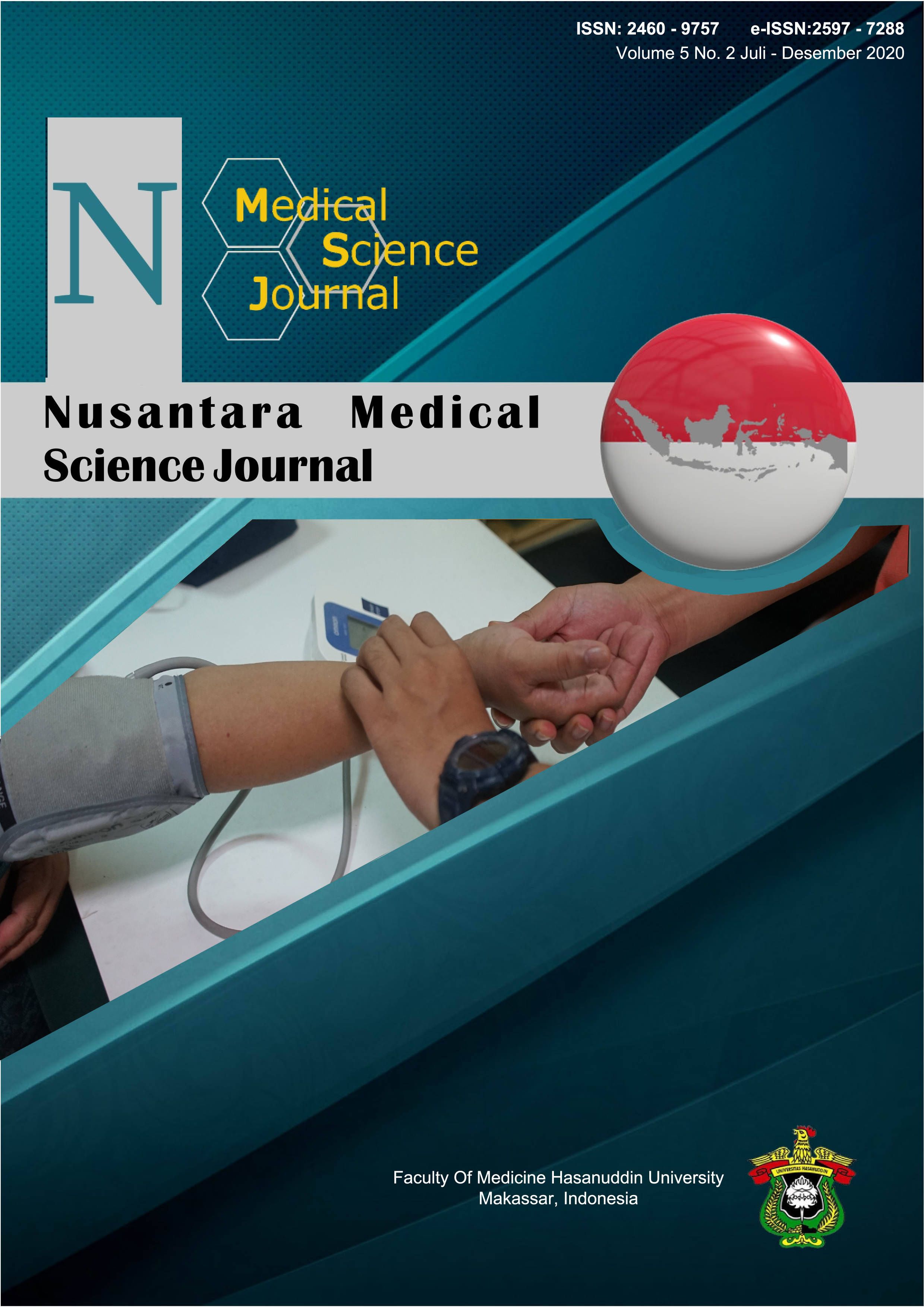Pulmonary Tuberculosis CT-Scan Features and Sputum Smear in Tertiary Referral Hospital
DOI:
https://doi.org/10.20956/nmsj.v5i2.13489Abstract
Introduction: Management of pulmonary tuberculosis (PTB) from primary and secondary health centers might affect the result of sputum acid-fast bacilli (AFB) smear and features of lung computed tomography scan (CT-scan) presented in tertiary hospitals. The study aims to investigate comparison between CT-scan features of PTB with sputum AFB smear in Wahidin Sudirohusodo Hospital as the top referral hospital in the Eastern part of Indonesia. Methods: This is a retrospective study of patients diagnosed as PTB by pulmonologist of nine months period. Patients with available CT-scan and sputum AFB smear results are included in the study. CT-scan features re-evaluated with RadiAnt DICOM viewer for standardized reading. The relationship between data obtained was analyzed with a chi-square test. Results: Sixty-one PTB patients were entered into the study. The three most common features found in CT were consolidation (93.4%) followed by Tree-in-bud (91.8%), and fibrosis calcification (85.2%). Relationship of CT features and sputum AFB smear was significant on cavity (p-value: 0.002) and pleural effusion (p-value: 0.020). However, unlike cavity (OR = 1.667), pleural effusion has opposite relationship (OR = 0.205) with sputum AFB smear. Conclusions: Pulmonary tuberculosis CT features seen in top referral hospitals can be very severe with consolidation and tree-in-buds as the most common features found in more than 90% of the cases. Feature of cavity may help radiologist to distinct highly active PTB with positive sputum AFB smear while presence of pleural effusion should raise the suspicion from pulmonologists to add further laboratory investigation.
References
World Health Organization. Global tuberculosis report 2018. Geneva: World Health Organization. 2017: 34. ISBN: 978-92-4-156564-6
Kementrian Kesehatan Republik Indonesia. Pedoman Nasional Pengendalian TB. 2014: 12, 77-81. ISBN: 978-602-235-733-9
Sugihantono, A. Kebijakan dan Langkah Operasional Dalam Eliminasi TBC, Penurunan Stunting dan Peningkatan Imunisasi Tahun 2018. Rakerkesnas 2018. 2018: 1-38. www.depkes.go.id
Menteri Kesehatan Republik Indonesia. Peraturan Menteri Kesehatan Republik Indonesia Nomor 56 Tahun 2014 Tentang Klasifikasi dan Perizinan Rumah Sakit. 2014: 6. www.yankes.kemkes.go.id.
Hadi,U. Kuntaman, Qiptiyah, M. Paraton, H. Problem of Antibiotic Use and Antimicrobial Resistance in Indonesia: Are We Really Making Progress?. Indonesian Journal of Tropical and Infectious Disease. 2013(4); 4: 5-8. http://dx.doi.org/10.20473/ijtid.v4i4.222
Wahidin Sudirohusodo Hospital. Infection Center: Jejaring RS Mitra. 2019: http://www.rsupwahidin.com.
Okur, E. Yilmaz, A. Saygi, A. Selvi, A. Sungun, F. et al. Patterns of Delays in Diagnosis Amongst Patients with Smear-Positive Pulmonary Tuberculosis at a Teaching Hospital in Turkey. Clinical Microbiology and Infection. 2006; 12(1):90–2. DOI: 10.1111/j.1469-0691.2005.01302.x
Dhingra, V.K. Aggarwal, N. Rajpal, S. Aggarwal, JK. Gaur, SN. Validity and Reliability of Sputum Smear Examination as Diagnostic and Screening Test for Tuberculosis. Indian Journal of Allergy Asthma Immunology, 2003; 17(2):67-69.
Desikan P. Sputum smear microscopy in tuberculosis: is it still relevant?. The Indian journal of medical research, 2013;137(3), 442–444. PMID: 23640550; PMCID: PMC3705651.
Gomes, Mauro, Saad Jr., Roberto, & Stirbulov, Roberto. (2003). Pulmonary tuberculosis: relationship between sputum bacilloscopy and radiological lesions. Revista do Instituto de Medicina Tropical de São Paulo, 2003; 45(5), 275-281. DOI: 10.1590/s0036-46652003000500007
Bays, A.M., Pierson, D.J. Tuberculous Pleural Effusion. Respiratory Care. 2012; 57(10), 1682- 1684. https://doi.org/10.4187/respcare.01443.
Chaudhuri, A.D., Bhuniya, S. Pandit, S. Dey. A., Mukherjee, S., Bhanja. P. Role of Sputum Examination for Acid Fast Bacilli in Tuberculous Pleural Effusion. Lung India. 2011; 28(1), 21-4. doi: 10.4103/0970-2113.76296.
Shaw, J.A., Irusen E.M., Diacon, A.H. Koegelenberg, C.F. Pleural Tuberculosis: A Concise Clinical Review. The Clinical Respiratory Journal. 2018; 12(5), 1779-1786. doi: 10.1111/crj.12900.
Botianu, P.V.H., Botianu A.M. The Challenge of Diagnosing Pleural Tuberculosis Infection. In: Méndez-Vilas.A (editor) Microbial Pathogens and Strategies to Combating Them: Science, Technology and Education. 2013; Pp.1950-6. ISBN: 978-84-939843-9-7.
Vorster, M. J., Allwood, B. W., Diacon, A. H., & Koegelenberg, C. F. Tuberculous pleural effusions: advances and controversies. Journal of thoracic disease, 2015; 7(6), 981–991. doi:10.3978/j.issn.2072-1439.2015.02.18
Downloads
Published
How to Cite
Issue
Section
License
Copyright (c) 2021 Nur Amelia Bachtiar, Sri Asriyani, Bachtiar Murtala, Irawaty Djaharuddin, Andi Alfian Zainuddin, Nikmatia Latief

This work is licensed under a Creative Commons Attribution 4.0 International License.









